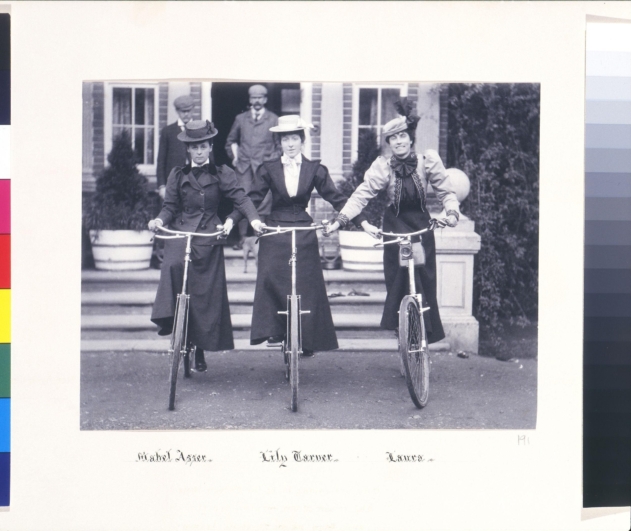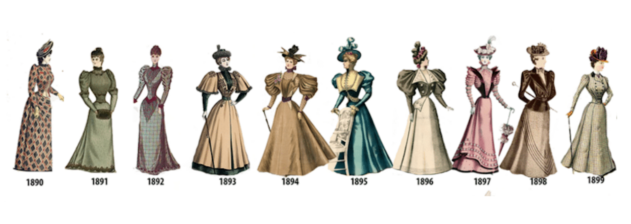Photography and fashion in the ‘Naughty Nineties’
We have now reached the 1890s in our blog series which aims to help you date photographs from fashion. Known as the ‘Naughty Nineties’, this was the decade that saw the witty plays and trial of Oscar Wilde; the formation of the French Cancan dancers; and the beginning of the suffragette movement.
Unsurprisingly, women’s fashion in this decade evolved radically to reflect the new era. More women were working and enjoying new freedoms. Young women, in particular, needed clothes that enabled them to cycle and play sports. This coincided with the introduction of electricity into clothing manufacturing, creating a boom in the ready-to-wear market.

Women in dresses, on bicycles. V&A Museum
In the same decade, technological advances also led to the advent of consumer photography – thanks to the introduction of the affordable, portable Kodak camera and flexible roll film. That’s why so many family historians possess images of their ancestors from that era.
Fashion magazines also became more widely available in the 1890s as advances in printing processes allowed photographs to be printed on the same page as text for the first time. This means we have plenty of resources to help us date those photographs!
1890s Women’s fashion
In the first years of the 1890s, the silhouette was a continuation of the late 1880s style, with the notable development of a small vertical puff at the shoulder. Skirts were bell-shaped, gored to fit smoothly over the hips, while bodices were marked by the large leg-o-mutton or gigot sleeves. The early shoulder puff grew greatly in size, reaching an apex in 1895. The width at the top and bottom of the silhouette was balanced by a nipped waist, to create an hourglass effect. Around 1897, the silhouette began to slowly shift with the introduction of the straight-front corset. This forced a woman’s chest forward and hips backwards into an “S” shape, and that became the dominant silhouette by 1900.
The general delineations of morning, afternoon, and evening wear held throughout the decade. Morning wear featured high necklines and long sleeves, while afternoon clothing opened at the neck and featured shortened sleeves, and finally, evening wear bared the chest and arms.

For working women, in particular, the shirtwaist ensemble was popular. This comprised a simple skirt, and a shirtwaist (blouse), that was tailored similar to a man’s shirt but could feature tucks, frills, and lace trimmings. The look was often completed with a jacket and straw boater hat. Shirtwaists could also be worn as part of a suit, often referred to as tailor-mades.
Women generally arranged their hair in high, neat chignons with soft curls at the front. Hats were an all-important accessory and were available in a variety of styles. Usually, 1890s hats were wide and heavily trimmed with tall upwardly curling feathers, ribbons, and flowers.
Outerwear evolved to accommodate the large and puffed sleeve, with jackets and coats also featuring the gigot. However, capes became the most fashionable choice as they fell gracefully over the expansive sleeve. A commenter noted in 1895 that cashmere shawls (previously women’s most prized possessions) were being used to cover pianos!
Sporting women
Female participation in sports – including basketball, gymnastics, golf, tennis, croquet and sea-bathing – expanded greatly in the 1890s. They wore either the standard shirtwaist suit or more specialised clothing.
Women, in particular, adopted the bicycle as a common form of transportation and needed appropriate clothing for this. The “bicycle suit” was created which consisted of a jacket and bifurcated bloomers, but most women opted for a shortened simple skirt worn over their bloomers, or a long skirt with a deep pleat in the back which allowed them to sit on the bicycle while still appearing to be wearing a skirt.

1890s Menswear
Menswear in the 1890s maintained an overall narrow silhouette; however, trousers became slightly more relaxed in cut. The frock coat remained fashionable for formal daywear until the turn of the century, as the morning coat slowly supplanted it. The latter featured a waistline seam and cutting away in the front, and it could be quite formal when paired with contrasting dark trousers and a top hat, or more casual as a three-piece tweed suit perhaps worn by a businessman.
The lounge or sack suit, featuring a single-breasted jacket without a waist seam, became the most common choice for working men and was increasingly worn by upper-class men as a relaxed alternative day suit. White tie and tailcoats remained the correct dress for evening events, worn with heavily starched, and sometimes pleated, white dress shirts. The dinner jacket or tuxedo introduced in the previous decade became an acceptable choice for evenings at home or in a gentlemen’s club throughout the 1890s.
Shirts were heavily starched and frequently featured stiff stand collars; although collars with turned-down wingtips were increasingly worn. As jackets were more frequently left open, shirts and waistcoats were sometimes made in vibrant colours. The top hat and bowler remained the most common forms of headwear, the former paired with more formal ensembles. During the 1890s, the bowler hat could be exaggeratedly tall, emphasising the narrow, tailored look. The Prince of Wales also popularised a variant of the fedora (a low, soft hat with a crease from front to back), called a Homburg.
1890s menswear also featured a great deal of sportswear, comprising light-coloured, often striped flannel, lounge suits paired with a straw boater hat. The reefer jacket, square and double-breasted, could be worn without a waistcoat for sporting and seaside activities. For shooting, a tweed Norfolk jacket, with its forgiving vertical pleats and characteristic belt, loose knee-breeches, and gaiters were most appropriate.
In our next blog, we look forward to taking you into a new century, as we explore the advances in fashion and photography in the first decade of the 1900s.